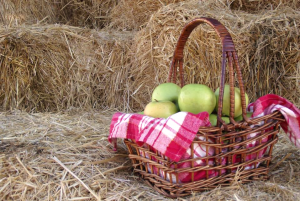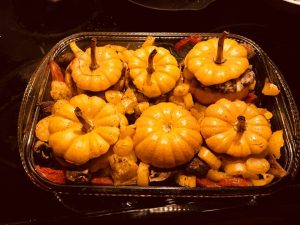 Halloween is the only time of year witches are in vogue. Suddenly everyone is interested in black magic, spell craft, hexing their neighbor, and a host of other things that bear little resemblance to actual Paganism. Despite the annual autumnal uptick in interest in all things occult, Halloween isn’t a Pagan holiday. That doesn’t mean we Pagans won’t dress up in costumes and join our Christian brethren in unholy revelry, general debauchery, and handing out candy to trick-or-treaters, but we do have our own holiday to celebrate, Samhain.
Halloween is the only time of year witches are in vogue. Suddenly everyone is interested in black magic, spell craft, hexing their neighbor, and a host of other things that bear little resemblance to actual Paganism. Despite the annual autumnal uptick in interest in all things occult, Halloween isn’t a Pagan holiday. That doesn’t mean we Pagans won’t dress up in costumes and join our Christian brethren in unholy revelry, general debauchery, and handing out candy to trick-or-treaters, but we do have our own holiday to celebrate, Samhain.
Samhain translates as sam, “summer,” and fuin “end.” With fluttering leaves in shades of copper, amber, and crimson, there can be no doubt that summer is truly at an end.
In antiquity, fire had a strong religious link, perceived as a gift to mankind from the sun. Seen as a supernatural force, fire both illuminated the darkness and brought destruction. The veneration of fire is particularly common in the colder regions of Europe, where long dark winters, filled with foul weather and oppressive overcast skies are winter’s norm.
As the sun-bleached grasses die back, withering to golden or russet, livestock which had been turned out to graze and fatten over summer, are rounded up and brought back to the farmsteads. Historically, on Samhain, a set of great bonfires were lit on the hill tops at sunset to honor the gods. The smoke of community bonfires was considered a purifying and cleansing element for people and livestock. The herds were driven between the pair of bonfires, the thick smoke causing insects to drop from their hides before being put into the fold. Any animals not needed as breeding stock were slaughtered to provide food for the clans.
The ritual bonfires served several purposes. Not only did they aid in removing insects, but the fire is an acknowledgement of the sun’s power by replicating its heat and light on earth. Afterwards, the ashes of the fires were spread on the fields as fertilizer for next year’s crop.
In addition to the agricultural rites, the festival of Samhain often contained horse races, fairs, markets, political discussions, and paying the annual tribute (taxes). Linked to the bonfire were the Celtic and Germanic customs of wheel-rolling. The ritual consists of rolling a flaming wheel (a round hay bale) downhill to a river. If the wheel reaches the river a good harvest is ensured for the following year.
Samhain was a time of ritual mourning, too. As the earth dies back and grows colder, the Celts not only mourned the death of summer, but they mourned for friends and family who died during the prior year, and they engaged in the triple killing (stabbing, burning, and drowning) of the sacral king. This ritual mourning makes the holiday both a joyous and somber event, where life and death are inextricably intertwined.
Under sacral kingship, the king is fundamentally bound to fortunes and prosperity of the land via a ritual marriage. A good king, devoted to his gods, would see a bountiful harvest, whereas a bad king, who neglected his religious duties, often brought barren fields. At Samhain, a straw man (scarecrow) representing the old king is stabbed, set alight, and thrown, still burning, into the river. This ensures that the new crops will have a fresh start without any bad luck or ill omens from the prior year lurking about.
One of the gods associated with Samhain is Daghda, a generous god possessing great wisdom, who is also known for his uncouth behavior. (Think of the uncle everyone has who farts prolifically and scratches himself publicly.) Counted among Daghda’s possessions is cauldron of plenty, which constantly remains full of food regardless of how much is eaten. He also has a club used to take life with one side and grant it with the other, giving him a strong association with death and rebirth.
Debunking Samhain Myths
Some people mistaken believe the Feast of Samhain is marks the first day of winter and the beginning of the Celtic New Year. This simply isn’t true. According to the calendars actually used by the Celts, the new year began in the spring. Also, Samhain and the other Celtic festivals were “movable feasts.” This means that they varied from year to year according to the position of the sun, just like the date of the solstices and equinoxes move a little each year, so the actual date of celebration can vary.
Your average Iron Age Celt had no idea when such midpoints occurred. In keeping with the calendars, the druids likely announced feasts according to lunar cycle. It was much easier to say, “The festival will be at the quarter moon.” This way the peasants had only to look skyward to know how far off the Feast of Samhain was.
For more on this see: The Celtic Calendar
Shifting the festival a few days either way was considered safer, too. During the “time between times” normal laws of the world are temporarily suspended. Spirits and the fae move freely between sidh (sacred mounds) and mortal lands. Unconstrained by the abeyance of man’s laws, these spirits cause all kinds of mischief. By shifting the festival, travelers were less likely to encounter such mischief as they passed through crossroads or other places thought to draw specters.
Another myth is that at Samhain, the veil between the worlds is thin and that the ancient people carved turnips or cabbages to create outdoor lanterns. Both of these originate from Christian traditions. During the Christian holiday Halloween, criers dressed in black paraded through the streets carrying lanterns made of turnips and tolling mournful bells, reminding Christians to pray for the souls of the dead. The lantern’s fame symbolized the souls trapped in purgatory.
Carving pumpkins is a uniquely American tradition because they are a “new world” food. That means they are native to the Americas. Christopher Columbus was the first European to set their eyes on a pumpkin patch–in Cuba on December 3, 1492. The colonists who landed in New England, in 1620, were introduced to pumpkins by the Wampanoag tribe. However, pumpkin pie did not make its debut in an English cookbook until 1675. Irish Catholics who immigrated to America during the potato famine (1843-1855) carved pumpkins rather than turnips, likely because a pumpkin is much easier to carve.
To learn more about American Halloween customs see: Halloween History
Ideas for Celebrating Samhain
- In the tree calendar, the time encompassing Samhain is the reed month. Reeds were used for thatching, woven into mats and baskets, burned for fuel, and even crafted into pipes. According to flower folklore, the reed symbolizes music, so taking in a concert or folk music festival is a wonderful way to celebrate the season. See more information about the tree calendar here: The Wheel of the Year
- Visit the graves of loved ones and don them with colorful bouquets of autumnal flowers. This is a time of mourning, so give yourself permission to experience the feelings of loss.
- Have a harvest themed supper, and if you have hunters in the family, feature some wild game.
- If you haven’t already done so, visit a u-pick pumpkin patch and apple orchard. Apples are not ready to harvest until after the first frost, which makes them an ideal Samhain fruit. Bobbing for apples is another a fun way to celebrate the season. Incorporate apples and pumpkins into your cooking to continue celebrating harvest’s bounty as we move into winter.
Apple-Cinnamon Muffins
 2 cups of shredded apples (pealed first)
2 cups of shredded apples (pealed first)
1 ½ c flour + more for dusting
1 c quick oats
4 tsps. baking powder
½ tsp salt
1 tsp cinnamon
½ tsp nutmeg
½ c butter (softened) + more to grease muffin tins
2/3 c packed brown sugar
1 c milk
1 tsp vanilla
1 egg
Preheat oven to 350 degrees. Grease muffin tins with butter and lightly dust with flour. Set aside.
Core and peel apples, grate in food processor, and put in colander to drain while working with other ingredients. Add 1 ½ cups of flour, oats, baking powder, salt, cinnamon, and nutmeg to a large bowl and stir until combined. In a separate bowl, cream 1/2 cup of butter with the sugar, then add milk, vanilla, and egg, mix until combined. Stir contents of flour bowl into butter mixture. Add grated apple, stirring until combined well. Fill greased muffin tins 2/3 full and bake for 20 min.
Makes 18 muffins.
Harvest Pumpkins
 ½ c dry lentils
½ c dry lentils
Black pepper
Cumin
½ c wild rice
1 tsp chicken bouillon powder (or 1 cube)
3 tbsp. butter
6 mini pumpkins
Salt
1 med. yellow onion
½ tsp dried parsley
1 tsp dried basil
8 cloves garlic
16 oz. Sausage
6 mushrooms
2 large heirloom tomatoes (1 red, 1 yellow) Approx. 1 ½ cups each, diced.
2 tbsp. olive oil
Preheat oven to 350 degrees.
Put ½ cup of dry lentils, 1 ½ cups of water, ¼ tsp pepper, and ¼ tsp cumin in a sauce pan and let simmer.
Put ½ cup of wild rice, 1 ½ cups of water, chicken bouillon, and 1 tbsp. butter in a second sauce pan and let simmer.
Cut tops off 6 mini pumpkins, scrape out seeds. Sprinkle insides of each pumpkin with salt and pepper. Place pumpkins in a large casserole dish. Into each pumpkin add 1 tsp of butter. Return tops to pumpkins. Add ¼ to ½ inch of water to dish, then roast in oven at 350 degrees while proceeding with remaining steps.
While pumpkins roast, dice 1 medium yellow onion and sauté in 1 tbsp. of olive oil over medium heat until onions are tender, then transfer onions to a large bowl. Into bowl, add 16 oz. of uncooked sausage. Add ½ tsp dried parsley, ½ tsp dried basil, ¼ tsp pepper, and ½ tsp salt. Finely chop 2 cloves of garlic and add to bowl. Drain excess water off lentils and rice, then add to bowl with sausage and onion. Set aside to let cool.
While lentils and rice are cooling, stem and dice mushrooms. Dice tomatoes. In a medium bowl toss mushrooms, tomatoes, remaining garlic cloves, remaining ½ tbsp. basil, remaining 1 tbsp. olive oil, ¼ tsp salt, and ¼ tsp pepper together. Set aside.
Once rice and lentils are cool enough to handle, using fingers, kneed together all ingredients in sausage bowl until well combined. Remove pumpkins from oven and take off tops. Spoon sausage mixture into each of the pumpkins, squishing down with back of spoon to make sure pumpkins are well filled. Return tops to pumpkins. Ladle tomato and mushroom mixture over the top of pumpkins and return to oven. Continue roasting at 350 degrees for another 35 to 40 min, to ensure sausage is cooked through.
Serves 6.
Cook’s note: This recipe came from the desire to create a hyper-local dish. The lentils were ones I picked up from the USA Dry Peas, Lentils, & Chick Peas Council at the Lentil Festival in Pullman, Washington. I also used Saint Maries Wild Rice, in keeping with the desire to use local ingredients. The pumpkins, onions, and tomatoes came from my garden, though, those can be easily found at local farm stands.